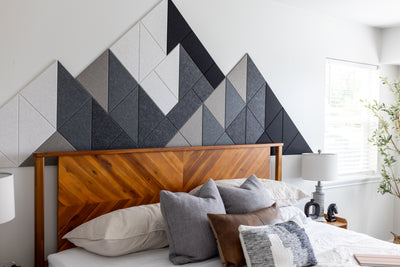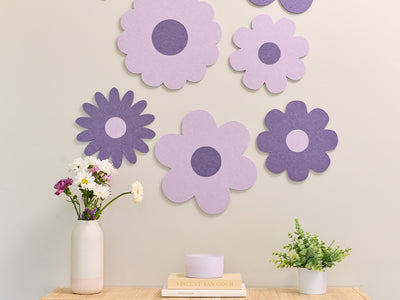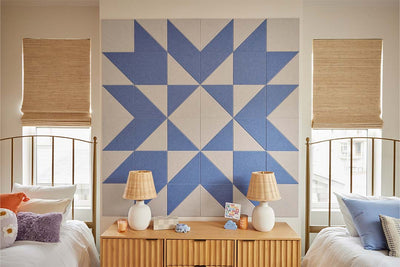What’s the Difference Between Soundproofing and Sound Dampening?
It is easy to confuse soundproofing and sound dampening as the same concept. The two concepts sound similar and are closely related, but they're not the same thing. Essentially, soundproofing a room means sound can’t effectively penetrate the exterior walls, while sound dampening is the process by which you can reduce the vibration of an object by applying a sound-dampening material over it. Rugs, carpets, foam, and sound-dampening felt can all dampen sound and soundproof a room, though there is a lot more that goes into it, which we'll get into below.

How Does Sound Dampening Work?
Sound dampening, which is also sometimes referred to as sound deadening, happens when you remove vibration energy from a structure or system by changing the sources producing the vibration. For example, you have a concrete wall in your home, and you line it with felt. Lining the wall in your room with felt reduces the wall’s vibrational frequency, thereby dampening or deadening, sound within the room.
Materials vibrate differently according to their physical properties, and they have natural frequencies and vibration frequencies. A material’s natural frequency is how fast it vibrates when there is no outside force acting on it. Its vibrational frequency is how quickly it vibrates when an external force acts on it.

When a material’s vibration frequency is equivalent to its natural frequency, it produces amplification. Amplification makes vibrations more grating and jarring while increasing their loudness. Adding materials that reduce vibration frequencies minimizes the vibration of a system and its components. Sound-dampening panels like those from Felt Right result in less harsh noise, preventing you from bothering or distracting neighbors and roommates.

A material’s sound-dampening ability relates directly to its NRC (noise reduction coefficient). The noise reduction coefficient measures a material’s “bounce back” ability. Materials with lower dampening qualities produce more bounce back, i.e. your drywall or concrete walls. Materials with higher dampening qualities make a lower bounce-back rate, which reduces unwanted vibrations and lowers sound.
Did You Know: Felt Right tiles have a noise reduction coefficient of .35, meaning they reduce noise by 35%. As a reference, carpet laid over concrete provides an NRC of .20 - .30, and concrete by itself provides an NRC of .00 - .20. Additionally, Felt Right’s stylish design lets you reduce bounce back within your room while adding to its visual appeal.

How Does Sound Absorption Work?
Sound dampening reduces materials’ vibrations and amplification. Sound absorption explains the materials’ ability to absorb sound waves rather than deflect them back into the room.
When sound waves strike a surface, some pass through the surface, while others don’t. Harder materials with less porous surfaces produce a higher sound reflection, while softer, more porous surfaces absorb more sound. When you line harder, less absorbent surfaces with softer, more porous materials, you decrease your room’s echoes and, thus, its reverberating sound.
Sound-absorbing materials help keep harsh sounds out of your home, such as:
- Heavy machinery
- Engines
- Power tools
- Generators

How Does Soundproofing Work?
Soundproofing refers to blocking sound with insulator materials that stop sounds from entering or leaving a room. These materials are solid and heavy because they must be dense enough to physically block sound and keep it in an enclosed space.
Soundproofing materials need to be installed inside walls because they need to create a sound barrier between two rooms. Creating a complete separation between the walls prevents sound from leaving one room and entering the other.
Because they need to be installed inside walls, and the materials are dense and cumbersome, they are not ideal for general noise reduction. You shouldn’t need to knock out walls to reduce the noise inside your apartment.
The downside of soundproofing is that it requires a complex procedure to accomplish, making it unattainable for everyone except professionals. For example, in recording studios, engineers may have to construct metal frameworks with multiple plasterboard layers to soundproof a wall and prevent noise from escaping the room.

Sound-Dampening Benefits of Acoustic Paneling
There are many benefits to sound-dampening panels, including easy installation processes, increased privacy, and a more comfortable environment for better entertainment.
Easy Installation
Felt Right’s acoustic panels combine creativity and functionality in one flawless design. Our “My Studio” page allows the user to customize their felt acoustic paneling to their desire, improving your room’s acoustic properties without the hassle of invasive installation techniques.
Increased Privacy
Whether you like to entertain, are working remotely, or have loud roommates, you might not like the thought of your neighbors eavesdropping on your conversations or complaining about the noise you make within the privacy of your home.
We all enjoy privacy, and Felt Right’s acoustic paneling ensures you never have to share what happens inside your home again. Echoes within your house or apartment might carry conversations over to your neighbors or make your entertainment system seem louder than it is. Acoustic deadening materials absorb your voices and entertainment so you can preserve your home’s privacy.

More Comfort
Comfort typically implies physical relaxation on the couch or a bed. Felt Right’s acoustic damping material won’t provide you with the same type of comfort as your bed, but it will undoubtedly create a more peaceful environment for your ears and mental state.
When focusing on work, the last thing you want to deal with is hearing your neighbor’s loud conversation or their music. Felt Right’s noise reduction wall panels reduce unwanted noise, so you don’t feel irritated or distracted.

Better Entertainment
You shouldn’t have to invest thousands of dollars into your home entertainment system to enjoy its capabilities. With the correct Felt Right acoustic paneling, you can get the most out of your entertainment system. You won’t need surround sound to hear every word of dialogue and feel immersed in the cinematic experience.
The Benefits of Using Felt as a Sound Dampening/Sound Absorbing Material
Mostly comprised of wool, felt is produced by pressing and matting fibers together. It is a very durable and stable material in response to moisture, greases, salts, detergents, and other chemicals. Additionally, its millions of fibers make it exceptionally resilient.
Felt is an ideal option for sound absorption because its millions of fibers create frictional energy that dissipates sound energy. Felt also has a high density and elasticity, which further demonstrates its effectiveness at reducing sound.

The Different Applications of Soundproofing Vs. Sound Dampening
Choosing how to approach your noise reduction solution depends on your situation. Soundproofing can be the only realistic solution if you’re a musician who needs complete sound isolation. Aside from musicians, YouTubers, streamers, and voice-over actors are other professions where sound integrity is non-negotiable.
On the other hand, soundproofing methods can be invasive and expensive, often requiring steep construction budgets that significantly change your home. Sound-dampening materials accomplish noise reduction on a scalable basis, allowing you to fully customize your designs without compromising your bank account or personal taste.

Create Your Customized Felt Right Sound Dampening Design Today
Felt Right’s felt wall tiles aren’t only useful for sound dampening and noise reduction because your felt panels can give you a new creative outlet while eliminating noise from your neighbors. Plus, your felt pin board can act as a more durable, more attractive bulletin board, allowing you to strategize while reducing unwanted sounds. Visit our My Design page today to start constructing your sound-dampening acoustic design.








